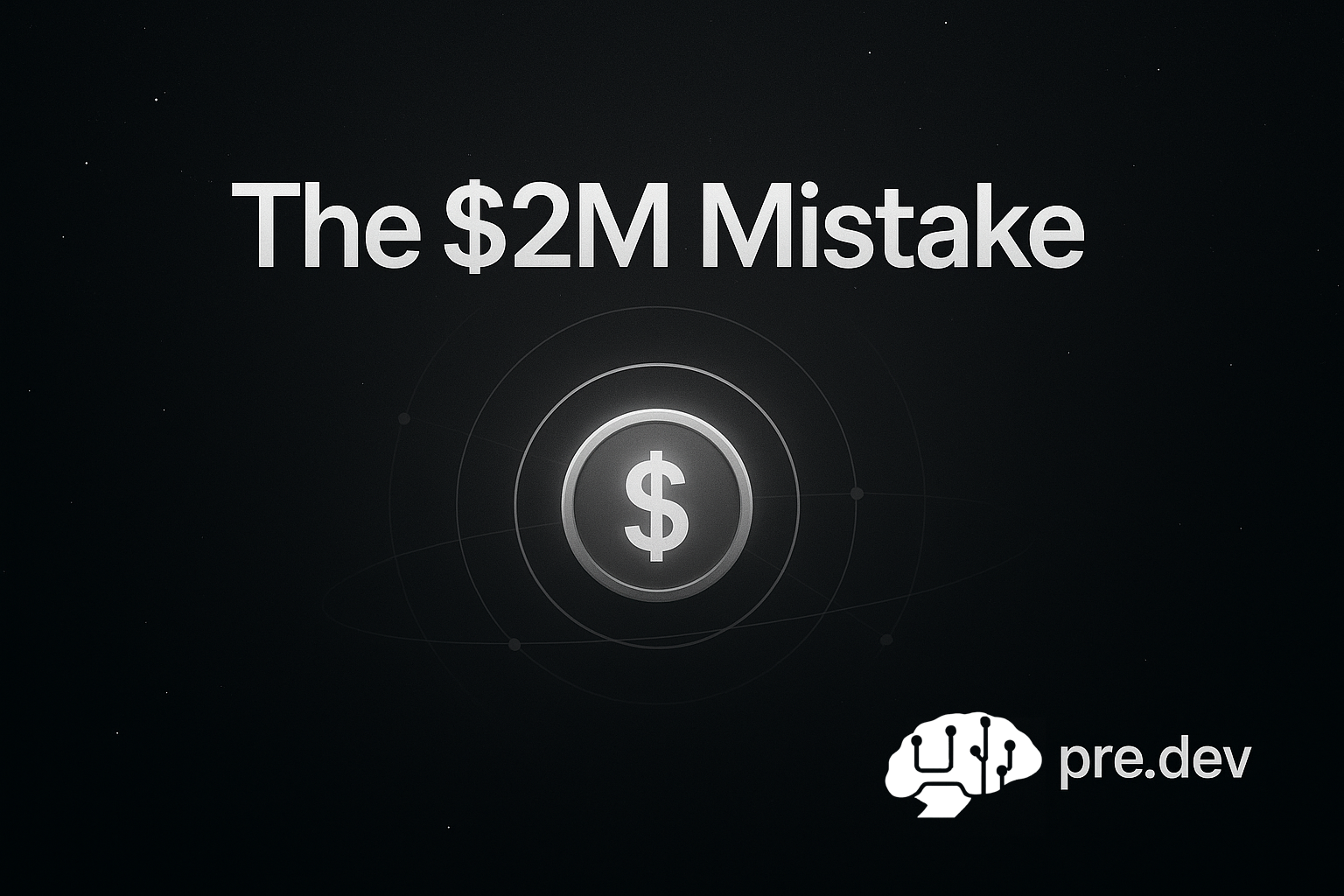The $2M Mistake: Why 90% of Founders Get Project Scoping Wrong (And How AI Fixes It)

90% of startups fail¹, and a significant portion make the same costly mistake in project scoping during the early stages. They think they’re building an app. They’re actually building a company. And they have no idea what that actually costs.
The $2M Reality Check
Picture this: You have a brilliant idea for an app. “It’s like Uber, but for dog walking.” You estimate it’ll cost $50,000 and take 3 months to build.
Six months later, you’ve spent $300,000 and you’re not even halfway done. The “simple” messaging feature turned into a real-time chat system requiring backend infrastructure you didn’t know existed. The “basic” payment processing became a nightmare of security compliance and fraud prevention. The “quick” user authentication evolved into a complex system of permissions, privacy controls, and data protection.
Welcome to the $2M mistake. It’s not just what you spend—it’s what you don’t have left when you realize you got it wrong.
The problem: Most founders dramatically underestimate project complexity and costs, leading to budget overruns and failed launches.
The math is simple. Get it wrong, and you’re dead.
The Three Deadly Scoping Sins
Sin #1: The Feature Fantasy
Every founder does this. They list features like items on a grocery list:
- User registration ✓
- Real-time messaging ✓
- Payment processing ✓
- GPS tracking ✓
- Push notifications ✓
What they don’t see:
- Scalable user management system (4 weeks)
- WebSocket infrastructure for real-time communication (6 weeks)
- PCI-compliant payment gateway integration (8 weeks)
- Mapping service integration with offline capability (10 weeks)
- Cross-platform notification system with delivery tracking (4 weeks)
That “simple” feature list just became 32 weeks of work. And that’s if nothing goes wrong.
Sin #2: The Architecture Assumption
“It’s just a simple app” is the most expensive phrase in startup history.
Here’s what founders think they’re building: A nice interface that saves data.
Here’s what they’re actually building:
- Frontend Application: User interface, responsive design, performance optimization
- Backend API: Business logic, data validation, security protocols
- Database Architecture: Data modeling, relationships, backup systems
- Authentication System: User management, permissions, password security
- Integration Layer: Third-party services, APIs, webhook handling
- Infrastructure: Hosting, scaling, monitoring, security
- DevOps Pipeline: Testing, deployment, continuous integration
Each layer has sub-layers. Each sub-layer has gotchas. Each gotcha costs money.
Sin #3: The Integration Illusion
“Just connect to Stripe/Google Maps/Twilio” might be the most dangerous words in the startup dictionary.
What founders hear: “Just plug it in”
What developers hear: “Build a custom integration system”
Real integration requirements:
- API authentication and key management
- Error handling and retry logic
- Rate limiting and quota management
- Data transformation and validation
- Webhook processing and security
- Fallback systems for service outages
- Compliance with service terms
- Testing across all edge cases
That “simple” Stripe integration? It’s 3 weeks of work if you do it right. 6 months of debugging if you do it wrong.
What Proper Scoping Actually Looks Like
Large enterprises invest heavily in project scoping and planning phases. They understand something most founders don’t: The cost of getting it wrong is always higher than the cost of getting it right.
The Enterprise Approach
Month 1: Requirements gathering and stakeholder alignment
Month 2: Technical architecture and risk assessment
Month 3: Resource planning and vendor evaluation
Month 4: Detailed project planning and timeline creation
Month 5: Budget modeling and scenario planning
Month 6: Final approval and team assembly
Result: Higher project success rates and better budget control
The Startup Reality
Day 1: “I have an idea”
Day 2: “Let’s find a developer”
Day 30: “Why is this taking so long?”
Day 90: “We’re out of money”
Result: High failure rate² with 34% failing specifically due to lack of product-market fit
How AI Changes Everything
Pre.dev brings enterprise-level scoping to startups. Here’s the process:
Step 1: Idea Analysis (10 minutes)
Input your idea in natural language. AI breaks it down into technical components, identifies requirements you didn’t know existed, and flags potential complications.
Step 2: Architecture Generation (30 minutes)
AI designs proper technical architecture based on your specific requirements. Not generic templates—custom solutions that consider your scale, security needs, and growth plans.
Step 3: Cost Estimation (15 minutes)
AI analyzes historical data from thousands of similar projects to provide realistic cost ranges. Includes infrastructure, development, testing, deployment, and maintenance.
Step 4: Risk Assessment (15 minutes)
AI identifies potential problems before they happen. Technical risks, integration challenges, scalability bottlenecks, security vulnerabilities.
Step 5: Team Matching (24 hours)
AI connects you with developers who have actually built what you’re trying to build. Not just developers—the right developers.
The Real Cost of Poor Scoping
What Poor Scoping Costs
The typical founder journey includes massive cost overruns and timeline delays. MVP development costs can range from $10,000 to $200,000³ depending on complexity and approach. Without proper scoping, founders often:
- Underestimate infrastructure needs by 200-300%
- Miss critical integration requirements that double development time
- Build features nobody wants while missing essential functionality
- Create technical debt that makes future development exponentially more expensive
The Enterprise Alternative
Smart founders are adopting enterprise-level planning approaches. Up to 50% of successful MVP costs go toward research and design⁴ - the planning phase that most startups skip. This upfront investment in proper scoping prevents the costly mistakes that kill projects later.
Why Proper Scoping Matters
The data is clear: 70% of seed investors now prefer to see an MVP before committing funds⁵. This means you need to build something that works, not just something that exists. Proper scoping ensures your MVP actually validates your business model instead of just burning through your budget.
Why Smart Founders Choose AI Scoping
Speed
Get enterprise-level project scoping in hours instead of months. While your competitors are still planning, you’re already building.
Accuracy
AI doesn’t get excited about your idea and forget about infrastructure. It considers every component, every integration, every potential problem.
Cost Control
Realistic budgets from day one. No more “we just need a little more money” conversations with investors.
Risk Mitigation
Identify problems before they cost you money. AI has seen every startup mistake and knows how to avoid them.
Team Fit
Get matched with developers who have actually built what you’re trying to build. Not just any developers—the right developers.
The Future Belongs to Smart Planners
The startup landscape has changed. Markets are more competitive. Investors are more sophisticated. Developers are more expensive. The margin for error has disappeared.
You can’t afford to guess wrong anymore.
Option A: Join the 90% who guess wrong and lose millions
Option B: Use AI to get enterprise-level scoping from day one
The choice seems obvious. The question is: why are most founders still choosing Option A?
Stop Guessing. Start Planning.
Your idea deserves proper scoping. Your investors deserve realistic budgets. Your team deserves clear requirements. You deserve to be in the 10% that gets it right.
Pre.dev gives you enterprise-level project scoping in 24 hours. Accurate budgets. Realistic timelines. Proper architecture. The right team.
90% of founders make the same $2M mistake. Don’t be one of them.
Get Your AI Project Scope in 24 Hours - Free Analysis →
Share this with another founder who needs to see this.
Sources
- Forbes - Startup Failure Rate Statistics
- DesignRush - Startup Failure Rate Statistics
- Flatirons - MVP Development Cost
- Ptolemy - MVP Development Costs and How to Save
- Ptolemy - MVP Development Costs and How to Save
#StartupSuccess #ProjectScoping #AIPlanning #FounderMistakes #StartupFunding

